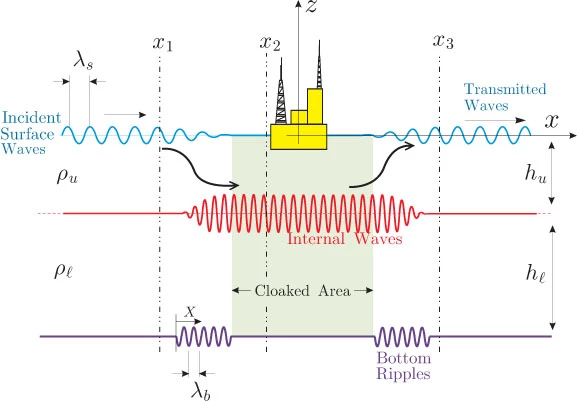Recent years have seen much progress in the development of invisibility cloaks which bend light around an object so it can't be seen, but can the same principles be applied to ocean waves that are strong enough to smash steel and concrete? That's the aim of Reza Alam's underwater “invisibility cloak.” The assistant professor of mechanical engineering at the University of California, Berkeley, recently outlined how to use variations of density in ocean water to cloak floating objects from dangerous surface waves.
When you look at the sea, it’s easy to imagine that it’s just one big mass of water, but it actually has a structure consisting of layers of different temperatures and densities. They aren't mere abstractions either. If you've ever gone scuba diving you may have swum down only to hit what seems like an invisible barrier that you have to actively push your way through. That’s the point where two of these layers meet.
“The density of water in an ocean or sea typically isn't constant, mainly because of variations in temperature and salinity,” said Alam. “Solar radiation heats the upper layer of the water, and the flow of rivers and the melting of ice lowers the water density near the surface. Over time, these effects add up to form a stable density stratification of two layers – with the lighter fluid layer on top and the more dense fluid layer below it.”

Where these layers meet “internal waves “can travel on the interface like those on the water’s surface. The difference is that the internal waves have the same frequency of oscillation as surface waves, but a shorter wavelength and slower speed.
What both surface an internal waves have in common is that they can be distorted by the seabed in the same way that a lens can distort light. With ocean waves, there’s an energy transfer involved that Alam was able to simulate in a computer. He found that by placing a corrugated or wavy pattern tuned to particular wavelength on the seabed it would cause surface waves to temporarily become internal waves.
By placing such a pattern under an oil rig, dangerous waves would shift to the subsurface interface, travel under the rig, and then return to the surface once they've cleared the pattern. In other words, the rig becomes invisible to surface waves. The idea is similar to land-based systems proposed for diverting earthquakes using rubber barriers or plastic rings, except in this case the waves are altered in order to divert them.
“Cloaking in seas by modifying the floor may play a role in protecting nearshore or offshore structures and in creating shelter for fishermen during storms,” said Alam. “In reverse, it can cause the disappearance and reappearance of surface waves in areas where sandbars or any other appreciable bottom variations exist.”
Alam presented his scheme to the American Physical Society’s Division of Fluid Dynamics earlier this month in San Diego, California.
Source: American Physical Society (PDF)






